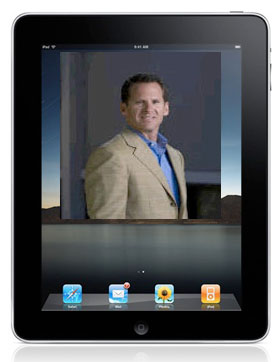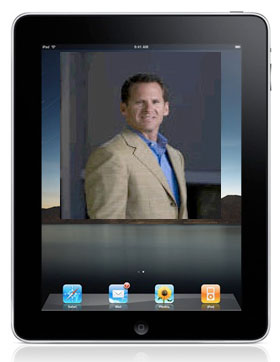 Following Kleiner Perkins’ iFund “Doubling Down” event today, I got the chance to speak with iFund managing partner Matt Murphy. Simply put, Murphy, who also managed the first iFund, thinks the opportunity with the iPad will be huge — potentially bigger than the first iFund. Obviously, Kleiner wouldn’t pump another $100 million into the fund if it didn’t believe that, but Murphy offered some insight into the firm’s thinking.
Following Kleiner Perkins’ iFund “Doubling Down” event today, I got the chance to speak with iFund managing partner Matt Murphy. Simply put, Murphy, who also managed the first iFund, thinks the opportunity with the iPad will be huge — potentially bigger than the first iFund. Obviously, Kleiner wouldn’t pump another $100 million into the fund if it didn’t believe that, but Murphy offered some insight into the firm’s thinking.
While much of the focus has been on what the iPad will do as a consumer device, Murphy makes the case for how well it should work as a revenue-generating machine for the companies developing for it. He noted that of the 14 companies that are currently a part of the iFund (3 of which are in stealth mode), four of them are already profitable just two years after the fund’s launch. He attributes this to three main things: the freemium model, Apple’s payment structure, and micro-payments.
One of those profitable companies is Shazam, the mobile music discovery service. The service noted today that it has seen over 15 million downloads on the iPhone (and iPod touch). Most of those are downloads of the free version of the app, but that free version has served as a gateway drug of sorts to get users hooked and eventually buying the premium version with more features. At $4.99, that paid version, Shazam Encore, is cheap enough that many users feel it is well worth the price.
Perhaps more importantly, it’s so easy to download thanks to the App Store’s built-in payment structure. It’s one click, and the app is yours. And Murphy thinks we’re on the verge of an explosion in in-app payments thanks to that structure.
One company, Booyah, which makes the popular location-based game MyTown (which we’ve covered quite a bit), is making good use of these in-app payments, Murphy notes. While the app is completely free, it allows users to buy upgrades within the game for small fees (ranging from $0.99 to $9.99). This is starting to take off, according to Murphy.
He notes that while free apps on the Facebook platform convert users to paying customers at a 3% to 5% conversion rate, the iPhone is seeing that conversation in the 12% to 15% range. That’s a massive difference. And Murphy attributes it to the way payment ideas are presented in apps in combination with Apple’s easy payment structure that happens behind the scenes (the App Store tied to your credit card). When you see a new cheap feature in an app, “for $0.99 i’ll try that out,” Murphy notes. Those purchases are an afterthought.
And the iPad will simply be an extension of all this, with the added potential benefit of even more in-app immersion. That’s what he sees as the iPad’s big benefit over the iPhone. “We want someone who cracks the code on a more immersive experience,” Murphy says.
And it’s important to note that this new iFund isn’t iPad-only. Before the end of this year, Murphy says there will be some 100 million devices running the iPhone OS (currently, there are around 75 million), Kleiner will continue to look at all types of companies doing both iPhone and iPad apps to invest this money into.
So what is he particularly excited about with regard to the iPad? Murphy reiterated John Doerr’s excitement about potential healthcare uses for the iPad and notes that they’re looking at one company in particular now that could come into fruition relatively soon (he wouldn’t say what it was). He also says that education is a potentially huge market for this new device.
When I asked about the buzz surrounding old school media companies coming to the iPad, Murphy said that he was reluctant about some of the companies being hired to work on these solutions because it’s not long-term defensible. That said, there is at least one pure content play in stealth mode that Kleiner has backed with the fund. It involves a well-known entrepreneur, but Murphy wouldn’t say anymore.
I asked why, given the success of the first iFund, Kleiner was “only” going with another $100 million for the fund? Why not go higher? Murphy noted that it’s likely just a starting point. For example, the original $100 million funded companies have seen some $330 million more pumped into them from outside the fund (yes, this is a bit skewed by Zynga, which just raised a massive $180 million new round). Murphy notes that this second iFund could be gone in as little as 12 months. It all depends on the quality of the companies sprouting up around the iPad (and continuing to sprout around the iPhone).
Finally, I asked Murphy about an area both him and I are excited about: location. Murphy notes that three of the 14 iFund companies, Pelago (the makers of Whrrl), Booyah, and Shopkick (makers of CauseWorld), are location-based at their core. He went on to note that all the companies in this space are doing exciting things with check-ins because it’s ultimately important data. “Foot-streams are more valuable than click-streams,” Murphy notes, taking a line from Whrrl’s playbook.
But Murphy notes that each of these companies is still searching for the Holy Grail: highly targeted location-based advertising. Once you understand that someone goes to Starbucks at a certain time everyday, you start to understand their behavior, and then ads become really interesting, he notes.
In terms of the iPad, Murphy wonders what uses people will come up with with regard to location. After all, it’s not a phone that you have in your pocket, and you probably won’t be taking it to dinner (unless you’re really rude). Again, he thinks a company like Booyah, with its heavy game element that will drive the immersion idea could come up with some cool things. But he feels there will be new types of apps that give you a different reason for why you check-in with the iPad.
In general, even within Kleiner Perkins, the iPad seems to be the undiscovered country. And that’s breeding a lot of excitement. Among the partners, there is no doubt that it won’t be long before there’s the first huge app for it. But it’s hard to base that off of pitches without the device itself out there. “You won’t know it until you see it,” Murphy says.
